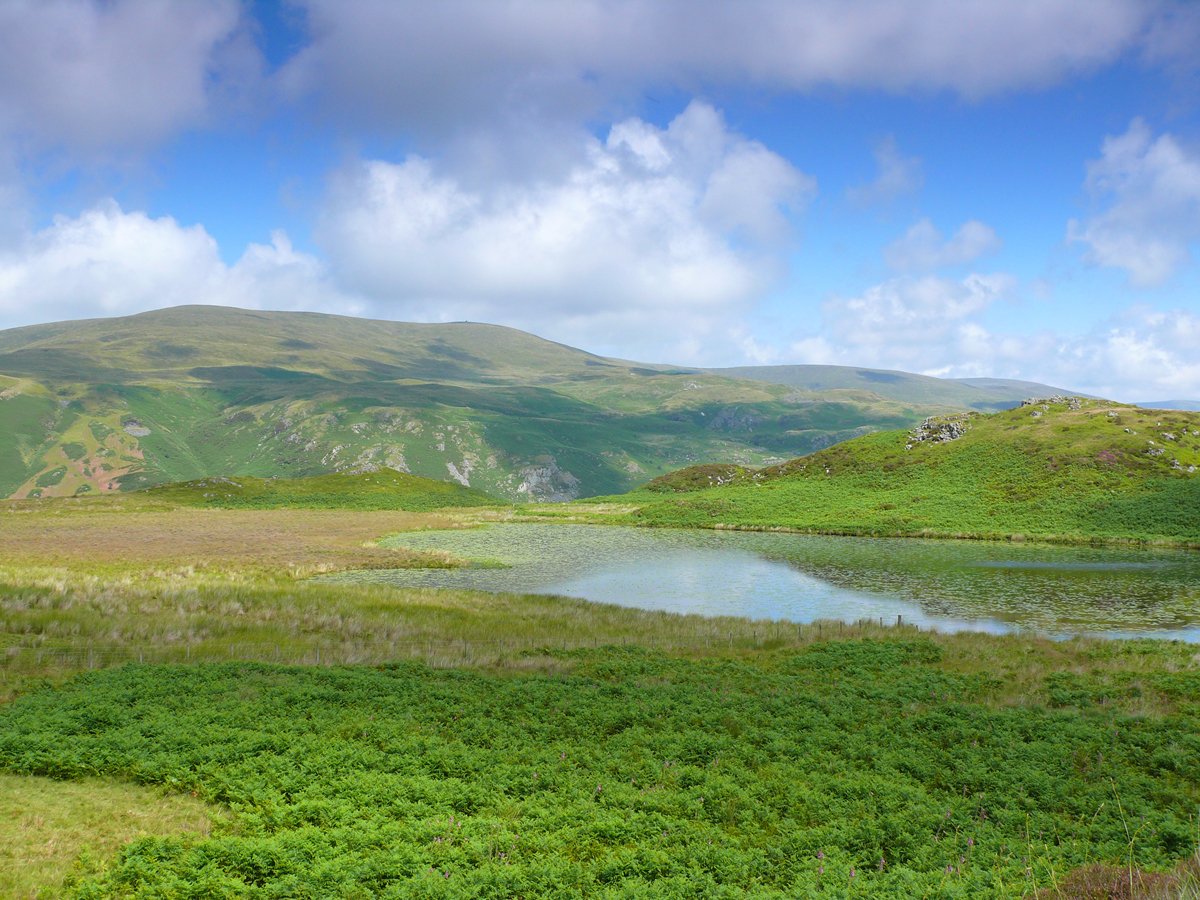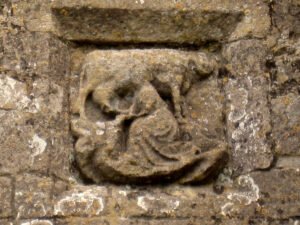The Milk of Kindness

Llyn Barfog*
Stories of magical or miraculous cows, some of whom freely gave their milk to whole neighbourhoods and never seemed to run dry are fairly common in Britain; there are several examples in Wales, also Shropshire, Lancashire and Warwickshire, to name just a few. For this Welsh version we visit a remote valley called Dyffryn Gwyn, close to Llyn Barfog, or “Bearded Lake”, itself in Cwm Maethlon (known in English as “Happy Valley” although this isn’t a good translation, the Welsh means something more like “Nourishing Valley”) near Aberdyfi in Gwynedd.
Nearby lived a poor farmer who somehow managed to capture one of the milk-white cows that would sometimes appear in the company of mysterious women dressed in green. He added the cow to his own herd and the milk, butter and cheese produced from the cow and her calves were considered the best ever, making the farmer very rich indeed. But the ungrateful man forgot that all his good luck was owed to the cow and he decided to fatten her for the butcher, fearing that she was growing old.
All the neighbours came to watch on the day the cow was due to be slaughtered, but the knife dropped from the butcher’s hand as he prepared to strike the killing blow. At the same moment, a cry was heard and a woman in green seen with her arms raised, crying out in a voice that carried over the valley:
“Come though Einion’s yellow one,
Stray horns – speckled one of the Lake,
And the hornless Dodin,
Arise, come home.”[1]
The cow and all her calves ran towards the woman but although the farmer chased them he was only in time to see lady, cows and calves all disappear into the dark waters of the lake. Elias Owen, the folklorist who recorded this tale, says that only the yellow water lilies of Llyn Barfog marked the spot where the cow disappeared. It’s tempting here to use the term “cash cow”, which still metaphorically stands for items providing a good profit while needing little maintenance. Few people had any sympathy for the farmer, even though he eventually became poorer than ever.
Wirt Sikes[2] expands this tale, adding that the original miraculous cattle were descended from the herds owned by the Gwragedd Annwn (literally, “wives of the Underworld”) and are said to be the origin of the famous Welsh black cattle. In this version the cows and her calves simply disappeared into the air, never to return, and although one cow remained her colour had changed from milk white to crow black. And in yet another version the cow would give enough milk to everyone who desired it, only disappearing when people sought to kill and eat her.
In Shropshire we have the story of the White Cow of Mitchell’s Fold, which is also the location of a well-known stone circle, less than a kilometre from the current Welsh border. During a desperate famine the cow would allow people to milk her provided they brought no more than one container. She never ran out of milk until one day when, we’re told, a wicked old woman took a sieve and milked the cow into that. Once the cow realised what was happening she ran off and was never seen again.
Catherine Johns[3] points out that we seem to value horses much more than cows, even though the latter have fed us and helped with farming for millennia; evidence of domesticated cattle in some parts of the world goes back over 8,000 years.
It may well be that in those early days most adults were unable to digest the lactose in milk, although this appears to have changed, in Northern Europe at least, during the Neolithic period. Milk also doesn’t keep very well but we learned ways to preserve it very early, producing butter, cheese and yoghurt, some of which had the additional benefit of being easier to digest. The importance of these foods to our ancestors can’t be emphasised too much, they may well have made the difference between starvation and survival.
Cattle are, or have been, useful in other ways, Johns tell us: providing dung, which burns well and discourages insects and also served as material for house building. Fat provided tallow for candles and bones could be worked into handles or needles, ground as fertilizer or used to make glue. Horns produced drinking cups and buttons while hides, of course, make leather for clothing, shoes and more. So much generosity surely deserves better treatment than cattle receive – and righteous indignation at the cruelty of the Welsh farmer or wicked old Shropshire woman would be misplaced at a time when many, perhaps most, cows in Britain are treated as little more than milk-producing machines.
Perhaps we haven’t always been so ungrateful; in Egypt Hathor was a fertile and nurturing mother who also provided love, joy, beauty and music, her beautiful horns reminding us of the moon’s crescent, while the full moon nestled between them. Davidson[4], in Milk and the Northern Goddess, adds that offerings of milk were made to deities and a dead Pharoah was represented as receiving new life from Hathor’s milk on his journey to the next world.
In Mesopotamia Ninhursag was supreme mother goddess and also associated with cattle, and Davidson adds that sacred cattle were kept at her temple at Lagash and milk from the sacred dairy was given to royal children, while in Norse myth the giant Ymir was nourished by a divine cow called Audhumbla, who also licked out of salty ice the form of the first human, grandfather to Odin and his brothers, who killed Ymir and made the world out of his body.[5]
And of course many of us immediately think of the “sacred cow” when considering India, where Hindus see cattle as embodiments of the fertility and wealth of the Earth herself. For one celebration called the Gopashtami people prepare cows, grooming and adorning them with jewelry and colour. We’re also told that Lakshmi, goddess of abundance, fertility and beauty, was churned into existence from a primeval ocean of milk. Davidson adds that in early texts the cow was associated with the goddess Aditi; milk was seen as a life-giving drink, symbol of purity as well as bounty and fertility.
In Britain too, carved stones from Roman times at both Hadrian’s Wall and in the Cotswolds suggest upright churns, clearly connected with the dairy and, according to Davidson, there is an assumption that the goddess celebrated here was Rosmerta, thought to mean “Great Provider”.
But perhaps most of all at Imbolc we honour Brigit, she who had the power to increase herds of cattle. People would leave out a cloth known as Bridie’s mantle in the hope that she would touch it when visiting the house; if its length had increased overnight this was a good omen. Born as her mother stepped across the threshold with a pail of milk one sunrise, Bridie belonged liminally between human and otherworld. She is said, adds Davidson, to have been washed in milk as an infant. More than a folk-tale; this custom was mentioned in 12th century church records. Brigit is also said to have been nourished on the milk of a special cow, white with red ears and procured from the otherworld by her foster father. These white, red-eared cows are known to have existed in Britain from Roman times – some say that the Romans brought them here for use in ritual as the native British cattle were black.

Brigit Milking a Cow – Carving on St Michael’s Tower, Glastonbury Tor[6]
All this and we haven’t yet mentioned the Milky Way, our own galaxy, said by the Greeks to have been created when Heracles was fathered on a mortal woman by the usual suspect – Zeus. Out of pity for the child, Hera nursed the baby, who bit her, causing milk to spill into the sky and forming the Milky Way. Indeed, the word “galaxy” itself originated from Proto Indo-European, the language from which the Greek, Latin, Celtic and most other European tongues derive: *g(a)lakt looking very much like our modern “galaxy”, and perhaps words like “lactic” and “lactation” too.
Opinions vary as to the meaning of the word Imbolc – but the Oxford English Dictionary gives the derivation from a Celtic word meaning literally “in the belly, or womb”. This is the time when sheep start to lactate and the grass to grow anew, while animals begin to come out of hibernation. When first domesticated cows still needed winter fodder in early spring, writes Davidson, and no milk could be taken until their calves were weaned. She adds that perhaps the gathering of greenery and flower garlands for May was partly due to the abundance of milk cattle produced in May; farms would put on celebratory breakfasts including many milk products, which must have seemed almost miraculous after Lenten fasting and the shortages of winter.
All of which leads me to ask myself anew: why are we not more grateful to the endlessly giving and lifesaving cow?
Geraldine Charles
Imbolc 2024
* Llyn Barfog photo by Ian Medcalf, CC BY-SA 2.0 <https://creativecommons.org/licenses/by-sa/2.0>, via Wikimedia Commons
[1] Owen, E. (2020) Welsh Folklore. Cockatrice Books. This is his translation.
[2] Sikes, W. (1880) British Goblins: Welsh Folk-Lore, Fairy Mythology, Legends and Traditions. London: Sampson Low, Marston, Searle & Rivington.
[3] Johns, C. (2010) Cattle: History, Myth, Art. London: British Museum Press.
[4] Davidson, H.E. (1999) ‘Milk and the Northern Goddess’, in The Concept of the Goddess, eds Sandra Billington & Miranda Green, London: Routledge.
[5] Ibid
[6] Photo:Martinvl, CC BY-SA 3.0 <https://creativecommons.org/licenses/by-sa/3.0>, via Wikimedia Commons

